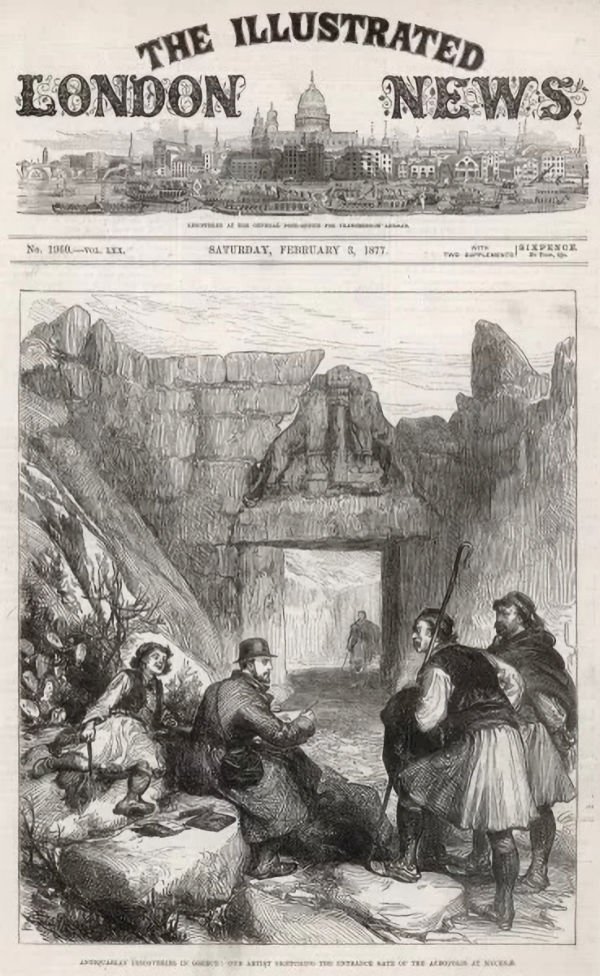Auron Tare
Në një botim të Gazetës së njohur britanike “Ilustratet London News” në daten 3 shkurt 1877, kushtuar germimeve arkeologjike të “arkeologut” gjerman Henry Schliman, ka nje gravure mjaft interesante.
Ne faqen e pare ndoshta vete gjermani Shliman apo ndonje pjestar i ekspedites se tij duke fjalosur me disa barinj te cilet duket se kullosnin bagetite e tyre perqark Portes se famshme te antikitetit te njohur si Porta e Luaneve te Mikenes.
Duhet thene se deri me atehere vetem nje grusht i vogel udhetaresh europiane kishin mundur te eksploronin zonen perqark Mikenes antike. Dikur nen sundimin e Ali Pasha Tepelenes kjo zone e Perandorise otomane e njohur si MOREA qe qeverisej nga i biri Veli Pasha, kishte qene nje zone e veshtire per udhetaret europiane.
Megjithese disa kishin mundur mberrinin deri ne More dhe te mernin edhe nje koncesion arkeologjik nga Veli Pasha i cili per cudine e europianeve qe kerkon “thesare” ishte mjaft i lexuar mbi antikitetin greko-romak mjaft ndryshe nga qeveritare te tjere otomane.
Megjithate ti kthehem botimit te London News. Nje gravure shume interesante e cila per mendimin tim ilustronte shtrirjen e komuniteteve shqiptaret te cilet gjendeshin ne shume hapsira te Peloponezit, dikur nje nga qendrat e rendesishme te botes antike.
Mora shkas nga kjo gravure per te qemtuar pak me shume se cfare shkruante nje nga emrat e rendesishme publike europiane te shek 19 mbi ngulimet shqiptare ne More. Jakop Philips Fallmerayer i cili shkruan ne 1836 pas nje udhetimi te gjate ne Turqine Europiane ku nder te tjera vizitoi edhe Peloponezin.
“The warriors of Pyrrhus, Teuta and Gentius spoke the tongue that is now used by Miaoulis and Contouriotis and the inhabitants of Boeotia, Hydra, Attica and a good part of the Morea [Peloponnese] today”
“Resettlement undertaken by Emperor Cantacuzene, The towns of Tabia and Londari are mentioned for the first time in this connection. The latter is situated near the one-time settlement of Veligosti. The former was established by the Albanian immigrants on the other side of the Tripolitza mountains, on the upper course of the Barbutzena”
Referring to the well-known byzantine historian Phrantzes Jakob Phillip writes: “Half of Peloponnese land was actually occupied by the Albanians at that time and they attempted to get the other half, too, both by force of arms and by negotiation with Sultan Mehmed II.”
Once curious piece of information is preserved in the funeral oration of Theodor Palaeologus, the successor of Cantacuzene in Mistra (1380-1407), that shows just how continuously and massively the Albanians flooded across the isthmus: “Ten thousand Illyrians, i.e. Albanians, were given residence in the Peloponnese by Theodor Palaeologus, and these ten thousand men brought their women and children, their possessions and animals with them.”
If we are to believe Chalkokondylas of Athens, they even conquered the towns of Athens and Levadia, taking them from the Catalonians, and were only driven out of the duchy in 1382 by Viscount de Roquebertin using Albanian and Sicilian forces”
Nerio of Corinth and the Parea of Athens invited Albanian military colonies to settle in Attica, Argolis, the Castellania of Corinth and the mountain valleys along the Gulf of Corinth. There are historical documents showing that the Albanians assisted the Castellan of Corinth and the ruler of Athens in that war, but not that their settlements were established there in the intermediate years of 1373 to 1382″ from Jacob Philipp Fallmerayer, Geschichte der Halbinsel Morea während des Mittelalters, volume 2 (Stuttgart 1836), pp. 240-263.











